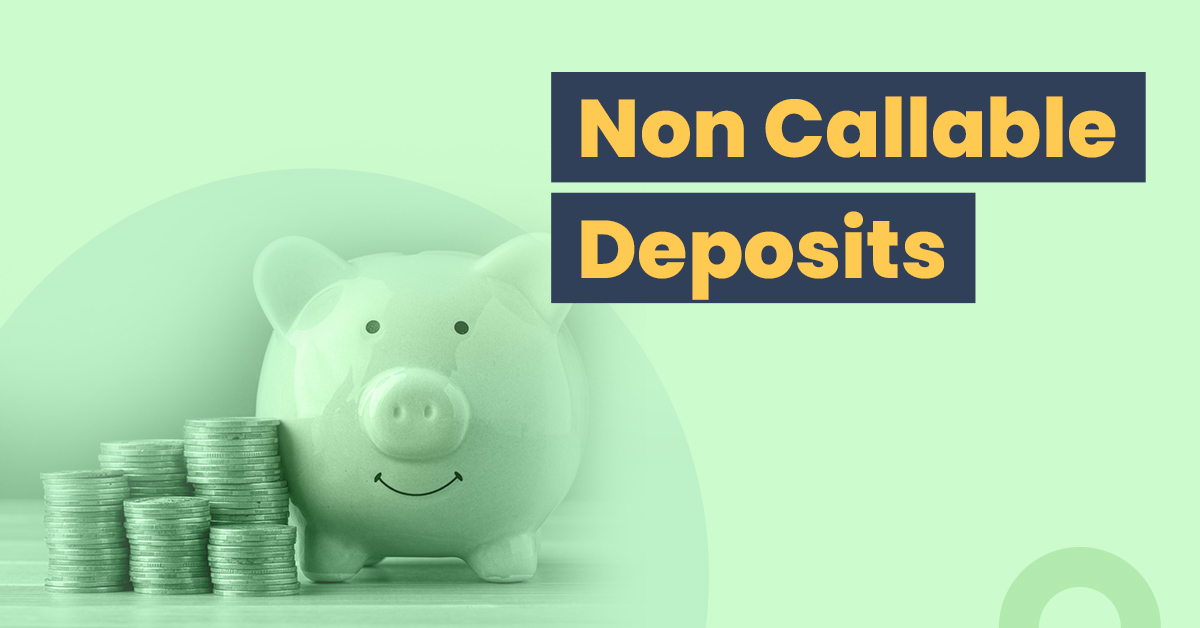Non-Callable Deposits: Definition, Components, Benefits, and Eligibility


Suppose you plan to open a new branch for your business after three years. You have saved enough capital right now and want to invest it. You have a fixed investment goal and do not want to risk losing money by investing in high risk schemes. So, you opt for a fixed deposit (FD) scheme for better risk-adjusted returns. Once you have decided that you do not want to utilise the investment for other purposes and choose to invest in FD, you should opt for non-callable deposits.
These FDs do not allow you to withdraw your deposit before the maturity date, which is not the case for callable FDs unless a court order is issued in the event of death or bankruptcy. Moreover, non-callable FDs also have a higher rate of interest than callable FDs! They are a great tool to achieve a fixed financial goal and a good option to diversify your investment portfolio.
But before you choose to invest, let us look at the definition, components, benefits, disadvantages, and eligibility criteria of non-callable deposits.
What is a Non-Callable Fixed Deposit (FD)?
Non-callable fixed deposit (FD) is a FD scheme in which you cannot withdraw the invested amount before the maturity date. Your investment remains locked in for the tenure you chose while opening a non-callable FD account.
In February 2015, The Reserve Bank of India (RBI) circulated a policy statement that allowed banks to offer the facility in which depositors are not allowed to withdraw money before the tenure ends. However, certain circumstances such as bankruptcy, deaths, and winding up of businesses allow premature withdrawal.
As the investments in non-callable FDs remain locked in for a predetermined tenure, banks offer a higher interest compared to callable FDs. Non-callable deposits came into the picture to help banks in asset-liability management and help depositors gain a higher interest rate.
Non-callable FDs are also known as non-withdrawable FDs. There are various components involved in non-callable FDs, let’s take a look.
Components of a Non-Callable FD
Following are the major components of non-callable deposits:
Minimum deposit: The minimum deposit amount varies from bank to bank. The minimum deposit for opening a non-callable FD account in HDFC Bank, ICICI Bank, and Axis Bank is Rs 2 crore. However, for the Bank of Baroda, the amount is Rs 15.01 lakhs. This amount changes from time to time.
Maturity period: The maturity period varies from seven days to 10 years, with each bank having its own rules. For ICICI Bank, the maturity period ranges from seven days to 10 years. But for HDFC Bank, this period ranges from 90 days to 10 years. The depositor chooses the maturity period while opening the account.
Auto-renewal option: The terms of auto-renewal also differ. Many banks, such as HDFC Bank and ICICI Bank, do not provide the auto-renewal option. However, the Bank of Baroda offers the auto-renewal facility for deposits less than Rs 2 crore under special terms.
Premature withdrawal facility: If you go by non-callable deposits definition, premature withdrawals are not allowed. However, banks do provide this facility under exceptional circumstances. If any judiciary, statutory, or regulatory authority orders the bank to issue a premature withdrawal, the bank must cooperate and offer this facility to the depositors. Cases involving deceased claim settlements are also eligible for premature withdrawal.
Loans and overdraft facilities: Some banks also offer loan and overdraft facilities against non-callable deposits as per the bank’s guidelines. For example, HDFC Bank offers an overdraft of up to 90% of the non-withdrawable FD amount. However, some banks do not offer this facility.
Why Do Banks Offer Non-Callable FDs?
The primary reason behind offering non-callable fixed deposits is to build a strong asset liability management system for banks it allows banks to further invest the money deposited in FD accounts in order to maximise the bank’s returns
In the case of callable FDs, banks must pay the deposited amount to the depositor on request for withdrawal. However, banks may not be able to make the payment if many depositors request withdrawals simultaneously.
On the other hand, once a depositor invests in a non-callable FD, banks do not need to worry about paying the money back until the tenure ends. This investment helps banks build stable assets and utilise the funds more flexibly. Non-callable FDs are stable sources of income for banks, and this, in turn, leads to building an efficient asset liability management system.
Advantages of Non-Callable FDs
- Depositors earn higher returns compared to normal FDs.
- Investing in non-callable FDs is a suitable way to diversify your investment portfolio.
- Non-withdrawable FDs have become a reliable source of funding for banks.
- They help banks in building an efficient and reliable asset liability management system.
Disadvantages of Non-Callable FDs
- Once you invest in non-callable FD, you will not have access to the investment amount before the maturity date. The investment will be locked for the predetermined tenure.
- The minimum deposit amount is very high. For instance, to open a non-callable FD account in HDFC Bank, you need to invest at least Rs 2 crores. So, a wide range of customers – like individuals with a fixed monthly salary – will find it challenging to invest in this option due to the lack of a huge corpus and the inability to access funds in an emergency.
- The investment is locked for the maturity period. So in case a new investment opportunity that offers higher returns than the existing scheme arrives before the end of the maturity period, the investor will not be able to benefit from that opportunity.
Why should you opt for Non-Callable FDs?
Following are a couple of reasons to opt for non-callable FDs.
- If you have a fixed financial goal for the next one, two, or five years, you should opt for non-callable FDs. Suppose you decide to expand your business into a new region after two years and have already arranged the capital, then you should invest in non-withdrawable FD. This way, you will earn interest on the invested amount, and you will not utilise the investment for any other purposes. Your investment is safe as returns of non-callable FDs are not linked to market fluctuations.
- Another reason is the chance to diversify your investment portfolio. If you already invest in high-risk investment schemes such as mutual funds and stocks, you should also consider investing in low-risk investment schemes. If you suffer losses in high-risk schemes, you can have predictable returns to balance the incurred losses through non-withdrawable FDs.
Eligibility criteria for Non-Callable FDs
Following individuals and organisations can invest in non-callable FDs:
- Residents
- Hindu undivided families
- Sole proprietorship firms
- Partnership firms
- Limited companies
- Trust accounts
Conclusion
Non-callable deposits present the best investment option when you have a fixed financial goal in mind and want to earn higher returns than normal FD schemes. This scheme is also favourable for banks as it helps them build a reliable source of income. Though only a specific class of customers can opt for non-withdrawal FDs, the scheme can help banks create a good asset liability management system and serve customers in the best possible manner.
FAQs
What is a callable FD?
A callable FD is an FD scheme in which you can withdraw the invested amount before the maturity date.
What is the maximum deposit in non-callable FD?
There is no limit on the maximum deposit in non-callable FDs.
What is the process for closing my non-callable FD account?
You can close the non-callable FD account upon maturity as per the bank’s rules and regulations.
What is the difference between callable and non-callable FDs?
In the case of callable FDs, you can withdraw the invested amount before the maturity date. However, you cannot withdraw the invested amount before the maturity date if you invest in non-callable FDs.
What is the minimum tenure for non-callable FDs?
The minimum tenure differs from bank to bank. For example, in ICICI Bank, the minimum tenure is seven days, but for HDFC Bank, the minimum tenure is 90 days.






